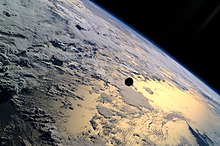PANSAT
| Mission type | Amateur radio satellite |
|---|---|
| Operator | USAF |
| COSPAR ID | 1998-064B |
| SATCAT no. | 25520 |
| Spacecraft properties | |
| Launch mass | 57 kg (126 lb) |
| Dimensions | 50 cm (20 in) |
| Start of mission | |
| Launch date | 30 October 1998, 17:20 UTC |
| Rocket | Space Shuttle Discovery STS-95 |
| Launch site | Kennedy LC-39B |
| Contractor | NASA |
| End of mission | |
| Last contact | 2003 |
| Orbital parameters | |
| Reference system | Geocentric |
| Regime | Low Earth |
| Eccentricity | 0.00072 |
| Perigee altitude | 551 km (342 mi) |
| Apogee altitude | 561 km (349 mi) |
| Inclination | 28.5° |
| Period | 95.8 minutes |
| Epoch | 30 October 1998[1] |
OSCAR ← OSCAR 33 OSCAR 35 → | |
PANSAT (Petite Amateur Navy Satellite, also known as OSCAR 34) was an amateur radio satellite. It was launched by Space Shuttle Discovery during the STS-95 mission as part of the third International Extreme Ultraviolet Hitchhiker (IEH-3) mission, on 30 October 1998 from Kennedy Space Center, Florida.[2][3]

The satellite was built by students from the Naval Postgraduate School in Monterey, California. It offered the possibility of packet radio transmission in BPSK or Direct-Sequence Spread Spectrum in the 70 cm band. The satellite was configured in a sphere-like shape, featuring 26 sides used for solar cell and antenna placement.[4] The spacecraft supplied direct-sequence, spread-spectrum modulation with an operating center frequency of 436.5 MHz, a bit rate of 9600 bit/s and 9 MB of message storage.
References
- ^ NASA Goddard Space Flight Center. "PANSAT". NSSDCA MAster Catalog. Retrieved 11 February 2020.
- ^ EOPortal.org. "PANSAT". Retrieved 11 February 2020.
- ^ Dirk Krebs, Gunter. "PANSAT (S97-D, PO 34, PANSAT-OSCAR 34)". Gunter's Space Page. Retrieved 13 Feb 2020.
- ^ Martin, Donald H. (2000). Communication Satellites. AIAA. ISBN 978-1-884989-09-4.
- v
- t
- e
- OSCAR 1
- 2
- 3
- 4
- 5
- 6
- 7
- 8
- 9
- 10
- 11
- 12
- 13
- 14
- 15
- 16
- 17
- 18
- 19
- 20
- 21
- 22
- 23
- 24
- 25
- 26
- 27
- 28
- 29
- 30
- 31
- 32
- 33
- 34
- 35
- 36
- 37
- 38
- 39
- 40
- 41
- 42
- 43
- 44
- 45
- 46
- 47
- 48
- 49
- 50
- 51
- 52
- 53
- 54
- 55
- 56
- 57
- 58
- 59
- 60
- 61
- 62
- 63
- 64
- 65
- 66
- 67
- 68
- 69
- 70
- 71
- 72
- 73
- 74
- 75
- 76
- 77
- 78
- 79
- 80
- 81
- 82
- 83
- 84
- 85
- 86
- 87
- 88
- 89
- 90
- 91
- 92
- 93
- 94
- 95
- 96
- 97
- 98
- 99
- 100
- 101
- 102
- 103
- 104
- 105
- 106
- 107
- 108
- 109
- 110
- 111
- 112
- 113
- 114
- 115
- 116
- 117
- 118
- 119

 | This spacecraft or satellite related article is a stub. You can help Wikipedia by expanding it. |
- v
- t
- e










